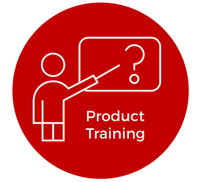Purposeful product training begins and ends with intent. That’s because by starting with your goals in mind, it’s easier to achieve them. That much should be obvious. Also, by understanding where you want to end up, you are better positioned to adapt if you find yourself going off track. Mind you; your success isn’t only down to your efforts but your employees too.
By explaining any training programmes that you’re offering your staff as well as your expectations of them once they’ve completed them, you’re allowing them to take ownership of their work. You’re paving the way for their success, and you can reap the benefits. 
Why retailers should focus on offering product training
From a particular angle, a question such as ‘Why should a retailer focus on offering product training?’ seems unnecessary. That’s especially true if you’ve read our piece on product knowledge and why it’s crucial for your success.
However, regardless of how easy the question is to answer, that doesn’t mean it’s not worth asking. Because contemplating the answer can lead you to explore the topic further, and result in you asking yourself more pertinent questions.
Such as this one: who, within your business, should undergo product training?
Again, the answer might appear simple. It’s not. You likely employ multiple people, and all of them fulfil different roles. There is your floor staff, your space planners, your merchandise managers, your buyers and so on. Ultimately, they all contribute to your bottom line. To help them support your goal, they all need to understand your products and how to position them in-store to earn maximum sales.
That’s why it is worth offering specialised training. Of course, any product training you provide does need to make sense to the job role, responsibility and purpose.
For example, your shelf planners should undergo training to better understand sales trends and what affects the sales of each product. Your space and floor planners might be better off with training on understanding product placement. Meanwhile, your sales staff and store managers would need specific training to help them deal directly with your customers.
[Online Course] Learn about product placement and pricing design with DotActiv Academy
Then, for your category managers, buyers and merchandise managers, you might only want to provide them with training that offers a broad understanding of your products, their part in the market, and what they offer your shoppers.
And what if you don’t provide them with adequate training?
That’s simple: let’s say, for example, that a customer approaches one of your floor staff and they don’t have the right knowledge to help. That employee has essentially let your customer down and damaged any trust that might have already been built up. What’s more, you could lose the customer.
If, on the other hand, it is your category manager who lacks the proper product knowledge, how do you expect them to create a category strategy that’ll benefit your business?
As a side note, if the training you want to provide isn’t core to what you do, you should consider outsourcing it.

What must a product training programme include?
While there shouldn’t be any debate around why you should offer product training, that doesn’t mean the same is true for what to include in a training programme.
There are multiple elements that you can incorporate into your curriculum, depending on what you want to achieve. For the sake of brevity, we’re only going to look at those components that will allow your staff to offer superior customer service. After all, this is as much about you providing a service that pleases your customer as it is about you attempting to close a sale.
1. A section on understanding the position of the product within its portfolio/market
The first part of any decent product training programme needs to focus on the actual position of a product within its portfolio. In other words, how is it presented in relation to the other products within the category?
Is it better priced? Is the quality greater than its direct competitor? Does it satisfy the customer’s needs or wants?
By understanding how a product fits into the bigger picture, your staff can figure out how to sell it. This ‘selling’ isn’t about pushing a product on a shopper as it is about matching up their need with the appropriate item. We’ll dive into the topic of matching shoppers to products in more detail below. For now, it’s worth pointing out that you need to be honest when you attempt to sell this way.
[Online Course] Learn about key merchandising principles and methods with DotActiv Academy
So what would a training programme look like if you wanted to include this element?
For one, your staff would need to understand data and how it affects the layout of your shelf. Since product placement can play a significant role in how a customer views and interacts with a product, it would also be worthwhile including practical how-to guides that you could implement in-store.
2. A section on how to pinpoint a product’s advantages and sell its features
Every product in your store has at least one feature that is worth highlighting. It’s the job of your sales staff not only to understand that feature but also how it relates to your customer. Of course, you can’t expect them to know them offhand; you first need to train them up.
As a side note, a product is not always limited to one feature. Instead, it depends on the complexity of the product and the need of your client. In other words, what do you need to focus on to make the sale?
Let’s look at a simple example such as a flash drive. There is only one real feature, and that is its memory size.
However, if you look at a more technical product such as a laptop or a computer, you’d find a dozen different features to highlight and sell it. While price certainly plays a part, and especially for your price-conscious customers; focusing on a product’s features can go a long way in persuading a customer to look past the price.
As for what a training programme would need to include, that’s the following: it would quite obviously need to outline the features and benefits of your products and how they relate to your business. It should also provide factual information that can be replicated in your environment to ensure that you meet your business strategies.
On the other side, you’d need to ensure that any product information is simple to understand and the item itself is easy to use, be that by a staff member as part of a live demonstration or the customer at home. After all, as much as you might want to persuade a customer to buy a product based on its features; it’s easier to sell when the customer sees it live in action.
3. Your staff must understand the customer to match up the right product to their needs
As much as deliberate product training revolves around learning the position of a product in the market and how to sell its features, there is more to it. In this instance, the ‘more’ we’re referring to isn’t so much directly related to the product as it is indirectly linked.
Let us explain:
If you want to sell a product, it’s not always a good idea to begin by selling its feature. Any good salesperson would tell you that. Instead, it’s about understanding the shoppers who walk into your store first.
Fortunately, there is a myriad of questions that you can ask them to find out. For example, what are they looking for in a product? What is their pain point? Are they price-sensitive or value-orientated? The more you ask them, the easier it will be to find a product that matches their needs.
Also, if you can address their pain point, there is no need for them to search elsewhere.
In this section, you should again focus on product knowledge and outline the various features and benefits. That’s merely to give you all the information you need so that when a customer walks in looking for a product, you know precisely what would match their needs. More importantly, you can explain why it meets their needs.
Beyond that, it’s crucial to include a customer service element, which would cover soft skills such as listening and problem-solving. Role-play exercises that mirror real-life situations are perfect for this since they can help you to develop and strengthen the interpersonal skills of your staff.
Conclusion
DotActiv Academy is DotActiv’s education portal where you can learn about all things retail and category management. From product placement and pricing strategies to merchandising techniques and the category management process, it’s there.
For more information about the various courses, visit the DotActiv Academy here.


